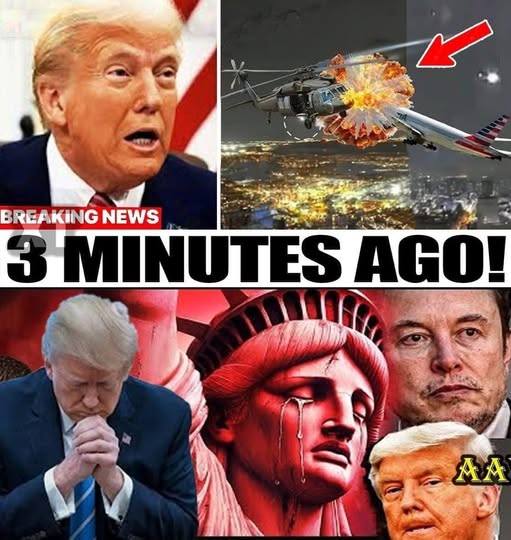US on High Alert After Strikes on Iran Nuclear Sites: Global Tensions Escalate
– by no name – Leave a Comment

10 Awesome TV Series That Got Cancelled Way Too Soon

301
INTERESTING FOR YOU


Bruce Willis’ Family Shares “Painful” Health Update
249

Here Are 12 Most Touching War Memes By Ukrainian Memes Forces
129

INTERESTING FOR YOU


From Albinos To Polygamists: The World’s Most Unique Families
684
It Turns Out Lance Can Actually Do This In Real Life!
649
The United States has raised its national threat level following a major military operation targeting Iran’s nuclear infrastructure. On June 21, 2025, American forces, in coordination with Israel, launched airstrikes on three key nuclear facilities inside Iran: Fordow, Natanz, and Isfahan. These developments have not only intensified conflict in the Middle East but also sparked urgent global diplomatic responses and widespread security measures across U.S. cities.
What Triggered the Strikes?

The strikes followed weeks of mounting tension between Iran and Israel, beginning with Iranian missile attacks and drone incursions into Israeli territory. U.S. officials cited actionable intelligence indicating that Iran was accelerating uranium enrichment activities in protected underground bunkers. According to the Pentagon, the decision to strike was made to prevent Iran from reaching nuclear breakout capability.
President Donald Trump authorized the mission—named “Operation Midnight Hammer”—after consultations with defense and intelligence advisors. The operation included 125 aircraft and the deployment of Massive Ordnance Penetrators (MOPs), GPS-guided bunker-busting bombs designed to penetrate fortified underground targets.
While President Trump declared the mission an “overwhelming success” on social media, international nuclear watchdogs such as the International Atomic Energy Agency (IAEA) have yet to confirm the true extent of the damage inflicted.
Strategic Significance of the Targets

The Fordow facility is deeply embedded in a mountain and has been central to Iran’s uranium enrichment program. Natanz and Isfahan are also integral components of Iran’s nuclear infrastructure. While the United States asserts that these sites were severely damaged, Iranian officials claim much of their nuclear material was evacuated prior to the strikes.
Independent verification is currently impossible, as IAEA inspectors have been unable to access the sites due to ongoing hostilities. However, satellite imagery released by U.S. intelligence appears to show large craters and infrastructure collapse at the Fordow site.
Homeland Security Responds

In the hours following the strike, the U.S. Department of Homeland Security issued a bulletin warning of a “heightened threat environment.” Major cities such as New York City, Los Angeles, and Chicago ramped up police presence at public venues, religious institutions, and diplomatic missions.
The NYPD confirmed additional deployments around synagogues, mosques, and international consulates. Mayor Karen Bass of Los Angeles announced similar measures, stating there were no credible threats but that authorities would remain vigilant.
At the national level, the State Department issued a worldwide caution alert for U.S. citizens abroad, citing increased risks of demonstrations or retaliatory actions targeting Americans.
Global Reactions: Mixed and Measured

Allied Nations
Several allies, including Australia and Japan, voiced cautious support for the strikes. Australia’s Foreign Minister Penny Wong stated that Canberra supported the action as a measure to deter nuclear proliferation but called for renewed diplomatic efforts to prevent further escalation. Japan expressed regret over the deteriorating situation and urged all parties to return to dialogue, emphasizing that peaceful resolution remains essential for regional stability.
European Union
Leaders of France, Germany, and the United Kingdom released a joint statement on June 22 urging restraint and calling on Iran to return to negotiations. While reaffirming their opposition to nuclear proliferation, the European bloc expressed concern that the conflict could spiral into a broader regional war if not managed carefully.
United Nations and Pope Leo XIV
UN Secretary General António Guterres warned that the situation risks “catastrophic consequences for civilians, the region, and the world.” He called for an immediate ceasefire and the reestablishment of diplomatic channels. Pope Leo XIV also appealed for peace, stating that “the tragedy of war must be stopped before it becomes an irreparable abyss,” and highlighting the humanitarian toll already witnessed in Gaza and other conflict zones.
Adversarial Responses
Russia and China strongly condemned the strikes, calling them a violation of international law and the United Nations Charter. Both countries urged the U.S. to de-escalate and emphasized that diplomacy, not force, should be the primary path forward. Iran’s Foreign Minister Abbas Araghchi stated that Tehran “reserves all options” in response to the attack but did not specify whether military retaliation was imminent.
Oil Markets and Economic Impacts

